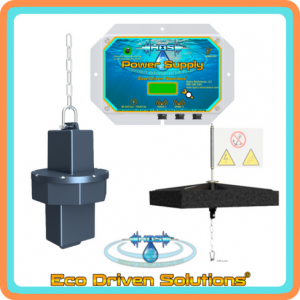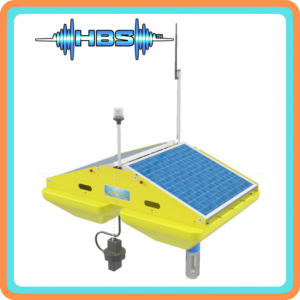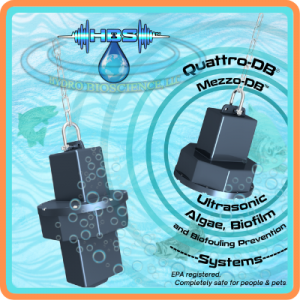Ultrasonic algae control systems now pushing the envelope of safe and effective algae control.
Recent peer reviewed publications confirm both the efficacy and safety of ultrasonic algae control systems.
Harmful algae bloom warnings (HABs) appear daily in headlines across the planet generating great, shared concern among many leading environmental researchers. Nutrient loading into waterways due to excessive fertilizer usage and runoff as well as wastewater mishandling or seepage into delicate water environments drives the now common occurrence of excessive algae growth and the associated HABs. When these blooms reach critical concentrated levels, toxins build up in the algae and if not properly addressed, these toxins, when released, cause irreversible environmental damage and physical harm to people and other species.
Despite being expensive, difficult to handle, store, and properly apply, chemical algaecides have been the most widely accepted and practiced methods of algal control, but they can be overused or misused causing similar damage to water biomes. Frequent use of chemical applications has also been shown to speed up the recycling processes of phosphates and nitrates, which algae feed on, and cause subsequent blooms to be even larger than those preceding. There is also the potential to create sterile water bottoms with misuse. As environmentalists and the public become more aware of the negative side effects of purely chemical mitigation techniques, the efficacy of their usage has come under scrutiny. Many locales even forbid chemical algal treatments at this point.
In response to many new EPA regulations which limit the application of chemicals targeting algae, alternative strategies have been explored but few seem to rise to the level of practical use, until now.
Ultrasonic technology has seen promising but limited success historically but recent, new advancements in the technology concerning both the effective applications and safety measures has caught the attention of a couple of prominent institutions.
A recently published, peer reviewed scientific study entitled “Effects of ultrasonic algae control devices on fish” (abstract available here) by Cornell University addresses a long-standing question on the safety of ultrasonic applications in algae control. In this study, centered around the Hydro Bioscience, LLC (HBS) manufactured Quattro-DB™, ultrasonic algae control technology was tested in both lab and field(natural) environments. After extensive testing over the course of several years, scientists studying the technology were unable to identify any negative effects on fish in the environments where they were tested.
According to the study “under controlled laboratory conditions, 7 recreationally or ecologically important fish species and local wild tadpoles were exposed to sound produced by the ultrasonic control devices. No behavioral effects were noted while fish and tadpoles were monitored during the exposure interval.” Monitoring included both behavioral activities where “No avoidance behavior was detected in either shallow or deep water”, and physiological health determined through thorough examination of specimens. Researchers stated: “no significant or harmful histological or morphological alterations to the skin, fins, gills, or internal organs were observed on either fish or tadpoles when specimens were examined...”
While the Cornell study centers around the absence of measurable negative effects on non-targeted species, a well-documented case study published in the Spring issue 2021 issue of, ClearWaters (scroll down to page 10), addresses the efficacy of these systems in algal management. Rich Abbott, coordinator for the Skaneateles Lake Watershed Protection Programs, meticulously details the installation of ultrasonic devices, data collection, observations, and conclusions of a multiyear study. Illustrating the difficulties, expense, and extreme care required to apply chemical control mechanisms, this study highlights the relative ease of installation and maintenance of the HBS produced units which were integrated in 2017. Combining HBS ultrasonic systems with aeration devices, this watershed saw an exponential decline in algal cell counts and has ended a 44-year reliance on chemical algaecides at a savings of over $100,000.
With harmful algal blooms now proliferating across the planet and at great monetary expense and health risks to those affected, this exciting technology presents itself as a very real and safe solution to algal bloom issues. These studies suggest that the eco-friendly and chemical free HBS ultrasonic algae control system is both effective in application as well as safe for the natural environment.
Antonio Trigiani, President of HBS states:
“Through thousands of applications and successes across the planet we understood that our ultrasonic systems were safe and effective. We now have the voice of respected researchers and peer reviewed publications to back that up.”
Those wishing to explore the technology of ultrasound in algae mitigation and general water management projects should contact Hydro BioScience, LLC at www.hydro-bioscience.com or call the HBS professionals at 888-500-5011.
###
Hydro BioScience, LLC is a scientific research, engineering, and manufacturing company, located in Piney Flats TN. Pioneers in the application of ultrasound for algae and biofilm management and eradication, HBS also manufactures the worlds most advanced water quality monitoring systems. HBS currently works with many municipalities, businesses, and private individuals in aiding the implementation of applications targeting the lowering of their chemical footprint, cleaning their water sources, and ensuring safe environmental conditions where water is concerned.
#ultrasonicalgaecontrol
#algaebloom
#cyanobacteria
Lou Bourbon
Hydro BioScience, LLC
+1 888-500-5011 ext. 125
email us here
Visit us on social media:
Facebook
Twitter
LinkedIn
Other
Legal Disclaimer:
EIN Presswire provides this news content "as is" without warranty of any kind. We do not accept any responsibility or liability for the accuracy, content, images, videos, licenses, completeness, legality, or reliability of the information contained in this article. If you have any complaints or copyright issues related to this article, kindly contact the author above.



